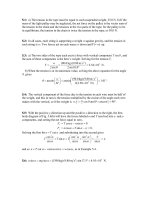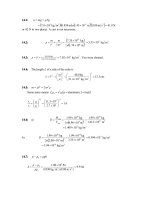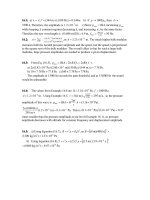- Trang chủ >>
- Khoa Học Tự Nhiên >>
- Vật lý
Tài liệu Physics exercises_solution: Chapter 25 ppt
Bạn đang xem bản rút gọn của tài liệu. Xem và tải ngay bản đầy đủ của tài liệu tại đây (317.83 KB, 22 trang )
25.1:
C.1089.3)s3600)(3)(A6.3(
4
ItQ
25.2: a)
A.1075.8bygivenisCurrent
2
)s60(80
C420
t
Q
I
b)
AnqvI
d
))m103.1(π)(C106.1)(108.5(
A1075.8
231928
2
nqA
I
v
d
=
.sm1078.1
6
25.3: a)
))m1005.2)(4π)(C106.1)(105.8(
A85.4
231928
nqA
I
v
d
sm1008.1
4
min110s6574timetravel
sm1008.1
m71.0
4
d
v
d
b) If the diameter is now 4.12 mm, the time can be calculated using the formula above
or comparing the ratio of the areas, and yields a time of 26542 s =442 min.
c) The drift velocity depends on the diameter of the wire as an inverse square
relationship.
25.4: The cross-sectional area of the wire is
.m10333.1)m1006.2(
25232
ππrA
The current density is
25
25
mA1000.6
m10333.1
A00.8
A
I
J
Therefore;haveWe neJv
d
3
28
195
25
m
electrons
1094.6
)electronC1060.1)(sm1040.5(
mA1000.6
ev
J
n
d
25.5:
constant.isso,
dd
vJvqnJ
,
2211 dd
vJvJ
sm1000.6)20.100.6)(sm1020.1()()(
44
1211212
IIvJJvv
ddd
25.6: The atomic weight of copper is
mole,g55.63
and its density is
.cmg96.8
3
The
number of copper atoms in
thusism00.1
3
moleg55.63
)moleatoms10023.6)(mcm1000.1)(cmg96.8(
233363
328
matoms1049.8
Since there are the same number of free
3
melectrons
as there are atoms of
3
mcopper
(see Ex. 25.1), The number of free electrons per copper atom is one.
25.7: Consider 1
3
m
of silver.
kg105.10so,mkg105.10density
333
m
andmol10734.9so,molkg10868.107
43
MmnM
328
A
matoms1086.5 nNN
If there is one free electron per
.melectronsfree1086.5arethere,m
3283
This
agrees with the value given in Exercise 25.2.
25.8: a)
C0106.0)C1060.1)(1068.21092.3()(
191616
NaCl
ennQ
total
.mA6.10A0106.0
s00.1
C0106.0
t
Q
I
total
b) Current flows, by convention, in the direction of positive charge. Thus, current
flows with
Na
toward the negative electrode.
25.9: a)
C.329
3
65.0
55)65.055(
||
8
0
3
8
0
8
0
2
8
0
ttdttdtIQ
b) The same charge would flow in 10 seconds if there was a constant current of:
A.1.41)s8()C329( tQI
25.10: a)
.A/m1081.6
25
)m103.2(
A6.3
23
A
I
J
b)
.mV012.0)A/m1081.6)(m1072.1(
258
ρJE
c) Time to travel the wire’s length:
hrs!22min1333
s100.8
A6.3
)m103.2)(C106.1)(m105.8)(m0.4(
4
2319328
I
nqAl
v
l
t
d
25.11:
.125.0
)m1005.2)(4(
)m0.24)(m1072.1(
23
8
πA
ρL
R
25.12:
m.75.9
m1072.1
)m10462.0)(4)(00.1(
8
23
π
ρ
RA
L
A
ρL
R
25.13: a) tungsten:
.mV1016.5
)m1026.3)(4(
)A820.0)(m1025.5(
3
23
38
πA
ρI
ρJ
E
b) aluminum:
.mV1070.2
)m1026.3)(4(
)A820.0)(m1075.2(
3
23
38
πA
ρI
ρJ
E
25.14:
Al
Cu
AlCu
Cu
Cu
Al
l
A
Cu
Cu
Al
Al
CuAl
ρ
ρ
dd
ρ
πd
ρ
πd
A
L
ρ
A
L
ρ
RR
44
2
2
mm.6.2
m1075.2
m1072.1
)mm26.3(
8
8
Al
d
25.15: Find the volume of one of the wires:
andso
R
ρL
A
A
ρL
R
mcb10686.1
Ohm125.0
)m50.3)(mOhm1072.1
volume
6
282
R
ρL
AL
g15)m10686.1)(mkg109.8()density(
3633
Vm
25.16:
mm625.1
2
mm25.3
cm75.1
2
cm5.3
2
1
r
r
25.17: a) From Example 25.1, an 18-gauge wire has
23
cm1017.8
A
A820)cm1017.8)(A/cm100.1(
2325
JAI
b)
2326
cm100.1)cmA100.1()A1000(
JIA
cm0178.0cm100.1(so
232
ππArπrA
mm36.02 rd
25.18: Assuming linear variation of the resistivity with temperature:
0
3
0
00
35.2
]C)20320)(C105.4(1[
)](1[
ρ
ρ
TTρρ
Since
,JE
the electric field required to maintain a given current density is
proportional to the resistivity. Thus
mV132.0)mV0560.0)(35.2( E
25.19:
8
8
2
1053.1
m80.1
m1075.2
L
ρ
L
ρL
A
ρL
R
25.20: The ratio of the current at
C20
to that at the higher temperature is
.909.3)A220.0()A860.0(
Since the current density for a given field is inversely
proportional to
),( JEρρ
The resistivity must be a factor of 3.909 higher at the higher
temperature.
C666
C105.4
1909.3
C20
1
)(1
3
0
0
0
0
ρ
ρ
TT
TT
ρ
ρ
25.21:
m.1005.2
)V50.1(
)m20.1)(m1075.2)(A00.6(
4
8
2
ππV
LI
r
πr
ρL
A
ρL
I
V
R
25.22:
m.1037.1
)m50.2)(A6.17(
)m1054.6()V50.4(
7
24
π
IL
VA
L
RA
ρ
25.23: a)
A.1.11
)m1044.2(
))m1084.0(4)(mV49.0(
8
23
π
ρ
EA
JAI
b)
.V13.3
)m1084.0)(4(
)m4.6)(m1044.2)(A1.11(
23
8
πA
LI
IRV
c)
Ω.28.0
A1.11
V13.3
I
V
R
25.24: Because the density does not change, volume stays the same, so
)2)(2( ALLA
and the area is halved. So the resistance becomes:
.44
2
)2(
0
R
A
ρL
A
L
ρ
R
That is, four times the original resistance.
25.25: a)
.mV25.1
m75.0
V938.0
L
V
L
RI
L
RAJ
ρJE
b)
m.1084.2
)m75.0)(mA1040.4(
V938.0
8
27
JL
V
L
RA
ρ
25.26:
)(
0
0
if
TT
R
RR
.C1035.1
)484.1)(C0.20C0.34(
484.1512.1
)(
13
0
0
RTT
RR
if
25.27:a)
.54.99)C5.11)(C0004.0(100100)(
1
fifiif
RTTRRR
b)
)C8.25)(C0005.0(0160.00160.0)(
1
fifiif
RTTRRR
.0158.0
25.28:
;
i
if
if
R
RR
TT
i
if
if
R
RR
TT
.C8.17C4
)3.217)(C0005.0(
3.2178.215
1
oo
o
25.29: a) If 120 strands of wire are placed side by side, we are effectively increasing the
area of the current carrier by 120. So the resistance is smaller by that factor:
.1067.41201060.5
86
R
b) If 120 strands of wire are placed end to end, we are effectively increasing the
length of the wire by 120, and so
.1072.6120)Ω1060.5(
46
R
25.30: With the
0.4
load, where r = internal resistance
Ir )0.4(V6.12
Change in terminal voltage:
r
I
rIV
T
V2.2
V2.2V4.10V6.12
Substitute for I:
r
r
V2.2
)0.4(V6.12
Solve for r:
846.0r
25.31: a)
219.0
)m050.0(
)m10100)(m1072.1
2
38
πA
L
R
V4.27)219.0)(A125( IRV
b)
J/s3422W3422A)125)(V4.27( VIP
J1023.1)s3600)(J/s3422(Energy
7
Pt
25.32: a)
700.0A00.4V8.2V8.2V2.21V0.24 rVV
abr
ε
.
b)
.30.5A00.4V2.21V2.21 RV
R
25.33: a) An ideal voltmeter has infinite resistance, so there would be NO current
through the
resistor.0.2
b)
;V0.5
ε
ab
V
since there is no current there is no voltage lost over the internal
resistance.
c) The voltmeter reading is therefore 5.0 V since with no current flowing, it measures
the terminal voltage of the battery.
25.34: a) A voltmeter placed over the battery terminals reads the emf:
.V0.24
ε
b) There is no current flowing, so
.0
r
V
c) The voltage reading over the switch is that over the battery:
.V0.24
s
V
d) Having closed the switch:
.V9.22)28.0)(A08.4(V0.24A08.488.5V0.24
ab
VI
.V9.22)60.5)(A08.4( IRV
r
,0
s
V
since all the voltage has been “used up” in the circuit. The resistance of the
switch is zero so
.0 IRV
s
25.35: a) When there is no current flowing, the voltmeter reading is simply the emf of
the battery:
.V08.3
ε
b) The voltage over the internal resistance is:
.067.0
A65.1
V11.0
V11.0V97.2V08.3
I
V
rV
r
c)
RV
R
)A65.1(V97.2
8.1
A65.1
V97.2
R
25.36: a) The current is counterclockwise, because the 16 V battery determines the
direction of current flow. Its magnitude is given by:
A.47.0
0.94.10.56.1
V0.8V0.16
R
I
ε
b)
.V2.15)A47.0)(6.1(V0.16
ab
V
c)
V.0.11V0.8)A47.0)(4.1()A47.0)(0.5(
ac
V
d)
25.37: a) Now the current flows clockwise since both batteries point in that direction:
A.41.1
9.01.45.01.6
V0.8V0.16
R
I
ε
b)
.V7.13)A41.1)(6.1(V0.16
ab
V
c)
.V0.1V0.8)A41.1)(4.1()A41.1)(0.5(
ac
V
d)
25.38: a)
A.21.00.9V9.1V9.1
bcbcbc
RVIV
b)
.1.26
21.0
48.5
)A21.0)()4.10.96.1((V0.8
RRIR
ε
c)
25.39: a) Nichrome wire:
b) The Nichrome wire does obey Ohm’s Law since it is a straight line.
c) The resistance is the voltage divided by current which is
.88.3









